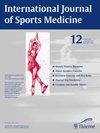Change in femoral cartilage cross-sectional area after aerobic and resistance exercise.
IF 2
4区 医学
Q2 SPORT SCIENCES
引用次数: 0
Abstract
We compared the immediate response and recovery of femoral cartilage morphology following aerobic or resistance exercise to a control condition. Fifteen healthy young males (23.9 years; 170.1 cm; 69.7 kg) visited the laboratory three separate days and randomly performed one of the 30 min exercise aerobic exercise (treadmill running); resistance exercises (leg presses, back squats, and knee extensions); or seated rest as the control, each followed by the 50 min recovery. Ultrasonographic images of the femoral cartilage cross-sectional area (CSA) were obtained before and after exercise and every 5 min thereafter. To test exercise effects over time, a mixed model analysis of variance and Tukey-Kramer post-hoc tests were performed (p<0.05). The femoral cartilage CSA was different (condition × time: F34,742=4.30, p<0.0001) that the femoral cartilage CSA was decreased after the aerobic (-5.8%, p<0.0001) and the resistance (-3.4%, p=0.04) exercises, compared to the pre-exercise levels. Deformed femoral cartilage CSA took 35- and 10 min to return to the pre-exercise levels after aerobic and resistance exercises (p>0.09), respectively. Thirty minutes of moderate exertion performing aerobic or resistance exercises immediately reduced the femoral cartilage CSA. A rest period ranging from 10 to 35 min was required for cartilage recovery after weight-bearing exercises.有氧运动和阻力运动后股骨软骨横截面积的变化。
我们将有氧运动或阻力运动后股骨软骨形态的即时反应和恢复情况与对照组进行了比较。15 名健康的年轻男性(23.9 岁;170.1 厘米;69.7 千克)分三天来到实验室,随机进行了 30 分钟的有氧运动(跑步机跑步)、阻力运动(压腿、深蹲和膝关节伸展)或坐姿休息中的一种运动作为对照,之后各进行了 50 分钟的恢复。在运动前后及之后每隔 5 分钟采集一次股骨软骨横截面积(CSA)的超声波图像。为了检验运动对时间的影响,分别进行了混合模型方差分析和Tukey-Kramer事后检验(P0.09)。有氧运动或阻力运动30分钟后,股骨软骨CSA立即降低。负重运动后需要休息10至35分钟才能恢复软骨。
本文章由计算机程序翻译,如有差异,请以英文原文为准。
求助全文
约1分钟内获得全文
求助全文
来源期刊
CiteScore
4.80
自引率
4.00%
发文量
111
审稿时长
3-8 weeks
期刊介绍:
The IJSM provides a forum for the publication of papers dealing with both basic and applied information that advance the field of sports medicine and exercise science, and offer a better understanding of biomedicine. The journal publishes original papers, reviews, short communications, and letters to the Editors.

 求助内容:
求助内容: 应助结果提醒方式:
应助结果提醒方式:


